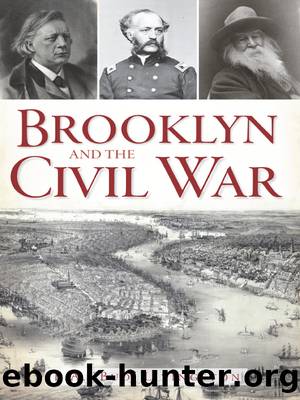Brooklyn and the Civil War by E.A. "Bud" Livingston

Author:E.A. "Bud" Livingston
Language: eng
Format: epub
Publisher: Arcadia Publishing Inc.
Published: 2012-01-15T00:00:00+00:00
The Monitor fights the Merrimac.
Ericsson advised Bushnell about the Galena and then showed his plans and a scale model for a craft he had developed for Napoleon III of France. Ericsson described his invention as an âimpregnable steam battery of light draught,â which would float with its deck nearly awash, its hull tapered at each side and its eleven-inch Dahlgren guns mounted side by side in a revolving turret. He had written to President Lincoln in August 1861 describing his invention but had never received a response.204
Bushnell sensed a patriotic yet profitable venture, and he hurried home to see a neighbor, Gideon Welles. Bushnell enthusiastically described a possible antidote to the Merrimacâs threat, and Welles sent him to Washington for a meeting with the ironclad board, composed of three naval traditionalists: Commodores Joseph Smith and Hiram Paulding and Commander Charles H. Davis.205
The navy brass, however, proved immune to Bushnellâs blandishments, and Davis even ridiculed the model. Undaunted by this setback, and through the intercession of John F. Winslow and John Griswold, friends of Secretary of State William H. Seward, Bushnell met with another inventor, President Abraham Lincoln. (Lincoln held patent number 6,469 for the creation of buoyant chambers to lift boats over shoals.)206 The president liked Ericssonâs invention and reconvened the naval board, but Davis proved resistant to even the presidentâs urgings, deeming the craft unseaworthy. Lincoln rose from the plain box he had used as a seat and announced, âWell, as the girl said when she put her leg in the stocking, I think there is something in it.â207
The resourceful Bushnell raced back to New York to see Ericsson. Mentioning no particular setback, Bushnell said that Davis had proffered arguments that he could not address and that it would be important for Ericsson to appear in person. The Swede, who could be as charming and persuasive as he was egotistical and arrogant, left immediately for the capital. The next day, he turned in a bravura performance, lecturing the naval board on seaworthiness and stability. Greatly impressed, yet hesitant over the memory of the Princeton fiasco, the board nevertheless made him an offer, albeit a very cautious one. The contract guaranteed complete success or a refund of all government money paid. The new partnersâWinslow, Griswold, Bushnell and Ericssonâwould receive $275,000208 if the government received delivery within one hundred days. It seemed impossible, and perhaps the spiteful ironclad board secretly hoped the project would fail, but Ericssonâs powerful ego allowed no doubt about eventual success. Work began immediately.209
The hull would be built at Thomas F. Rowlandâs Continental Iron Works on Calyer Street, in the Greenpoint section of Brooklyn; the plates, bars and rivets would be supplied by two upstate New York firms, Winslowâs Albany Iron Works of Troy and Griswoldâs Iron Works of Rensselaer. The Delamater Iron Works of New Yorkâs West Street would manufacture the steam machinery, boilers and propellers, and the aptly named Novelty Iron Works would build the unique revolving turret. The group would pay inventor Theodore Timby $5,000 for each turret used, even though Timbyâs patent would not be granted until September 1862.
Download
This site does not store any files on its server. We only index and link to content provided by other sites. Please contact the content providers to delete copyright contents if any and email us, we'll remove relevant links or contents immediately.
| United States |
In Cold Blood by Truman Capote(3136)
Steve Jobs by Walter Isaacson(2765)
The Innovators: How a Group of Hackers, Geniuses, and Geeks Created the Digital Revolution by Walter Isaacson(2495)
All the President's Men by Carl Bernstein & Bob Woodward(2263)
Lonely Planet New York City by Lonely Planet(2102)
The Room Where It Happened by John Bolton;(2032)
And the Band Played On by Randy Shilts(2014)
The Murder of Marilyn Monroe by Jay Margolis(1979)
The Poisoner's Handbook by Deborah Blum(1977)
The Innovators by Walter Isaacson(1971)
Lincoln by David Herbert Donald(1868)
A Colony in a Nation by Chris Hayes(1796)
Under the Banner of Heaven: A Story of Violent Faith by Jon Krakauer(1684)
Amelia Earhart by Doris L. Rich(1585)
The Unsettlers by Mark Sundeen(1584)
Birdmen by Lawrence Goldstone(1533)
Dirt by Bill Buford(1518)
Zeitoun by Dave Eggers(1517)
Decision Points by George W. Bush(1463)
